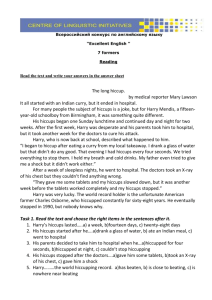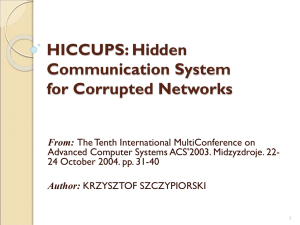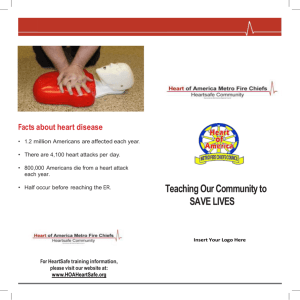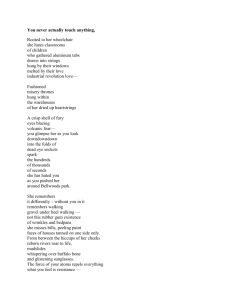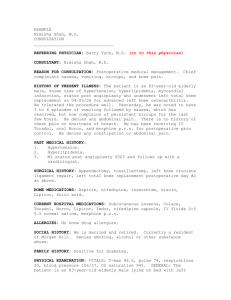IGCE Session - Baylor College of Medicine
advertisement
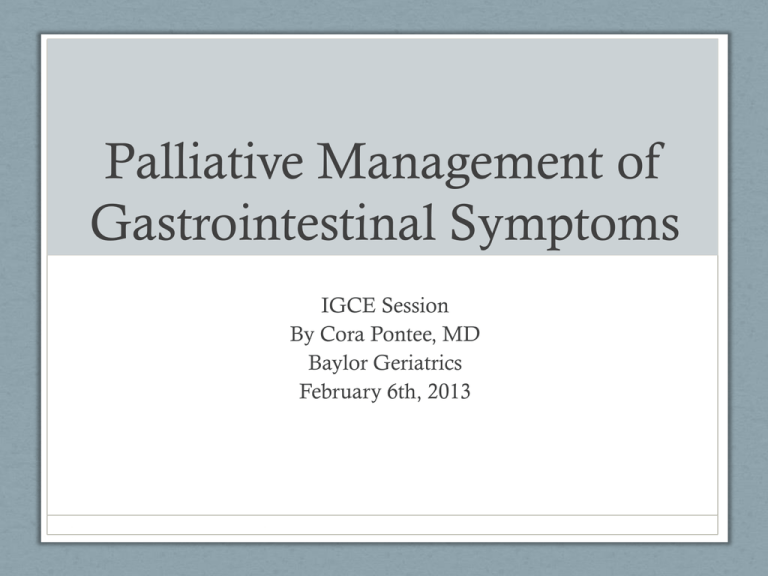
Palliative Management of Gastrointestinal Symptoms IGCE Session By Cora Pontee, MD Baylor Geriatrics February 6th, 2013 Common Gastrointestinal Symptoms in Palliative Patients • Oral discomfort • Dysphagia • Nausea and vomiting • Hiccups Objectives • To acquire knowledge of current evidence in managing GI symptoms • To recognize oral discomfort and hiccups as treatable symptoms • To apply principles of management of GI symptoms to clinical practice Causes of Oral discomfort: Definitions • Xerostomia: Dryness of the mouth resulting from diminished or arrested salivary secretion • Dysgeusia: An impairment or dysfunction of the sensation of taste • Stomatitis: The inflammation of the mucous lining of any structures of the mouth, which may involve the cheeks, tongue, gums, lips, and roof or floor of the mouth • Mucositis: inflammation of a mucous membrane The Free Dictionary By Farlex Causes of Oral discomfort • Oral pain: angular stomatitis, dental caries, poorly fitting dentures, XRT or chemo induced stomatitis or mucositis, candidiasis, burning mouth syndrome • Xerostomia: related to cancer (head and neck), dehydration, radiation, drug therapy (anticholinergic, psychotropic, opioid, cardiovascular) • Dysgeusia: sinusitis or other infection, xerostomia, medications (antidepressants, HIV meds, chemotherapy), vitamin or mineral deficiency (zinc) Denture stomatitis • Definition: oral candidiasis that can occur in healthy adults wearing dentures • May present as bleeding, swelling, burning sensation, xerostomia, or cacogeusia • 35-50% of people wearing complete dentures Altarawneh et al, “Clinical and Histoligic Findings of Denture Stomatitis as Related to Intraoral Colonization Patterns of Candida albicans, Salivary Flow, and Dry Mouth,”J Prosthodont, 2012 Management of Oral Discomfort Xerostomia treatment options • Salivary substitute or oral gel every 1-2 hours or sugarfree gum • Malic acid 1% spray • Oral care: encourage family members to keep patient’s mouth moist (oral swabs to bedside) • Increase liquid PO intake; try frozen juices, popsicles, ice chips, Resveratrol • Pilocarpine 5 to 10 mg three times daily (watch for respiratory secretions or diarrhea) Gomez-Moreno G. et all, “Effectiveness of Malic Acid 1% in Patients with Xerostomia Induced by Antihypertensive Drugs,” Med Oral Patol Oral Cir Bucal 2012 Furness S et al, “Interventions for Management of Dry Mouth: Topical Therapies,” Cochrane Database Syst Rev 2011 ALTENS • Acupuncture-like Transcutaneous Electric Nerve Stimulation • 47 patients with cancer of the head and neck who were 3 to24 months from completing radiotherapy (mean age 60 years) with xerostomia • Patients received twice weekly ALTENS sessions over 12 weeks • Six month Xerostomia-Related Quality of Life Scale (XeQOLS) scores showed 86% of patients received a positive treatment response • Now entering Phase 3 studies Wong RK et al, “Phase 2 Results from Radiation Therapy Oncology Group Study 0537: a Phase 2/3 Study Comparing Acupuncture-like Transcutaneous Electric Nerve Stimulation Verses Pilocarpine In Treating Early Radiation-Induced Xerostomia,” Cancer 2012, Sept 1 Mucositis: Physiology The Biology of Blood and Marrow Transplantation, Volume 11 Issue 12, Dec 2005 Treatment of Mucositis • Chlorhexadine gluconate (Hibiclens, Betasept) • Combination mouthwash preparations with: • • • • • • Diphenhydramine Lidocaine Loperamide Nystatin Tetracycline hydrocortisone • Lidocaine 2% q4 to 8 hrs, 50/50 mixture with famotidine • Sucralfate suspension swish and swallow q 3-4 times daily • Doxepin oral rinse up to every 4 hours • Opioids (topical, parenteral) Clarkson JE et al, “Interventions for Treating Oral Mucositis for Patients with Cancer Receiving Treatment,” Cochrane Database of Syst Rev, October, 2010 Laser Therapy in Mucositis • 16 children (mean age 9.4 years) with chemotherapy-induced mucositis • All children treated with GaAIAs diode laser with 830 nm wavelength, repeated every 48 hours until healing of lesion occurred • On average 2.5 treatments in a period of 1 week were sufficient to heal the lesion; pain relief noted immediately after each treatment Cauwels RG and Martens LC, “Low level laser therapy in oral mucositis: a pilot study,” Eur Arch Paediatr Dent, 2011 Dysphagia • Definition: Difficulty in swallowing or inability to swallow The Free Dictionary by Farlex Dysphagia • Oropharyngeal dysphagia • Obstructing esophageal lesions • Esophageal dysmotility (neuromuscular, autoimmune) • Cognitive impairment Oropharyngeal Dysphagia • Upright positioning in bed, sitting at a table for meals • Changing consistency of food (soft, pureed, thickened liquids) • Careful hand feeding by caregivers • Videofluoroscopy and Speech therapy consultation Deane K et al, “Dysphagia occurs frequently in Parkinson's disease although patients themselves may be unaware of swallowing difficulties. Speech and language therapists in conjunction with nurses and dietitians use techniques that aim to improve swallowing,” Cochrane Database of Syst Rev, Jan 2001. Esophageal obstruction • Surgical resection or laser ablation • Placement of esophageal stent (SEMS) • Placement of gastrostomy tube • Help family cope with anxiety about patient’s poor PO intake • Clarify goals of care • Consider artificial nutrition and hydration Larssen L et al, “Long-term outcome of palliative treatment with self-expanding metal stents for malignant obstructions of the GI tract,” Scand J Gastroenterol, Oct 2012 Artificial Nutrition and Hydration (ANH) • Feeding tubes: nasogastric or percutaneous endoscopic gastrostomy tube • First PEG in 1980 • Research studies indicate events with PEG • Total parenteral nutrition • Rarely beneficial for cancer patients due to metabolic derangements, cachexia syndrome • Benefit for post-surgical oncology patients expected to recover bowel function • Adverse effects: infections, liver failure, thrombosis • IV hydration or subcutaneous hypodermoclysis Finucane TE et al. Tube Feeding in Patients With Advanced Dementia: A Review of the Evidence. JAMA. 1999; 282(14) 1365-1370 Gillick MR. Rethinking the Role of Tube Feeding in Patients with Advanced Dementia. NEJM. 2000; 34 (3) 206-210 Nausea and Vomiting Definitions • Nausea: A feeling of sickness in the stomach characterized by an urge to vomit • Vomit (v): To eject part or all of the contents through the mouth, usually in a series of involuntary, spasmic movements The Free Dictionary by Farlex Nausea and Vomiting Diagnostic Work up • Blood chemistries: calcium, sodium, BUN, creatinine, bilirubin • Drug levels (theophylline, digoxin, anti-epileptic drugs) • Neuroradiologic imaging to evaluate for sources of increased intracranial pressure or brainstem causes or vertigo and nausea • Abdominal imaging • HIDA scan Nausea from GI tract • Bowel inflammation or compression………………… ………………………………. • Haldol (D, H1, M1), metoclopramide (D2), olanzapine (H1, M1) • Drugs (iron, NSAIDS, alcohol, antibiotics) • Stop drug, add PPI, H2 blocker • Constipation • Laxative, enema • Tube feedings (abdominal distention, diarrhea) • Reduce volume or change from bolus to continuous • Thick respiratory secretions, cough-induced vomiting • Nebulized saline, expectorant if cough reflex intact, anticholinergic if no cough reflex Nausea from Chemoreceptor Trigger Zone • Metabolic (renal, liver failure, or tumor products) • Haldol (start at 0.5-1 mg q6 or q12), olanzapine • Hyponatremia • Treat underlying etiology • Drugs (opiates, chemotherapy, digoxin, carbemazepine, antibiotics, theophylline) • Decrease drug dosage or discontinue drug if possible Nausea due to Vestibular etiology • Middle ear infections • Antibiotics, decongestants • Motion sickness …………………. • Scopolamine (M1) or meclizine • Vestibular • Meclizine, consider ENT consult Pullens B and van Bentham PP, “Intratympanic gentamycin for Meniere’s disease or syndrome,” Cochrane Database of Syst Rev 2011 Nausea due to bowel obstruction • Therapeutic goal to manage symptoms in terminal patients (pain, cramps, nausea, emesis) • Dexamethasone (may relieve malignant bowel obstruction) • Transdermal scopolamine (slows gut, causes dry mouth, urinary retention, confusion) • Glycopyrrolate (slows gut, causes dry mouth, urinary retention, confusion) • Hyoscyamine (slows gut, causes dry mouth, urinary retention, confusion) • Octreotide (expensive, reduces gut secretions) Hiccups • Definition: involuntary, intermittent, spasmodic contraction of the diaphragm and intercostal muscles. Muscle contraction results in a sudden inspiration and ends with abrupt closure of the glottis, thereby generating the characteristic ‘hic’ sound. Hiccups often occur with a frequency of 4 to 60 per minute, remaining relatively constant in a given individual. Lembo A, “Overview of hiccups”, Up to Date 2011 Hiccups • Hiccup bout: lasts up to 48 hours • Persistent hiccups: continues after 48 hours up to 1 month • Intractable hiccups: continue longer than 1 month Pathophysiology of hiccups • Neural pathways of the hiccup reflex arc: • Afferent limb of phrenic and vagus nerves and sympathetic chain • Central mediator • Efferent limb of phrenic nerve, nerve connections to glottis and inspiratory intercostal muscles • Thought to involve the medulla oblongata, reticular formation of the brainstem, nuclei of phrenic nerve, and hypothalamus Image from Journal of Pain and Symptom Management, Vol 38, Sept 2009 Etiology • Psychogenic • gastric distension, aerophagia, sudden change in GI temperature • Alcoholism, acute alcohol ingestion • Arrhythmia-induced syncope (both cause and effect) • Weight loss, insomnia Etiology • Foreign body adjacent to tympanic membrane • Infections: pneumonia, pharyngitis • Asthma • CV: arrhythmia, MI, pericarditis, thoracic aortic aneurysm, PE • Cerebral lesions, MS Treatment options • Non-pharmacological • Pharmacological • Surgical Calsina-Berna A et al, “Treatment of Chronic Hiccups in Cancer Patients: A Systematic Review,” Journal of Palliative Medicine, 2012 Non pharmacological treatment of hiccups • Accupuncture • Nebulized saline • Folk remedies: • • • • • • • Traction on the tongue Pressure over the eyebrow area Valsalva maneuver Drinking a glass of water through a straw Breath holding Sudden fright Irritation of the vagus nerve by supraorbital pressure or carotid sinus massage Pharmacological treatment of hiccups • Baclofen • Gabapentin when CNS lesions are present • Chlorpromazine 24-50 mg IV/IM • Haldol 2-5 mg • Metoclopramide 10 mg q8 hrs • Anticonvulsants (phenytoin, valproic acid, carbemazepine) • Muscle relaxants, sedatives, analgesics • Dexamethasone, amantadine, nifedipine, methylphenidate Menon M, “Gabapentin in the treatment of persistent hiccups in advanced malignancy,” Indian J Palliat Care, May 2012 Calsina-Berna A et al, “Treatment of Chronic Hiccups in Cancer Patients: A Systematic Review,” Journal of Palliative Medicine, 2012 In Summary… • Discussed current evidence in managing GI symptoms including oral discomfort, dysphagia, nausea and vomiting, and hiccups • Discussed treatment options for oral discomfort and hiccups • Discussed principles of management of GI symptoms that can be applied clinically Questions?

